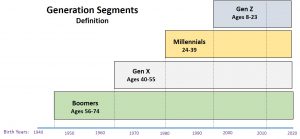By now marketers know the Millennials quite well. Their desires for experiences over products, authenticity, and to rent, share, and barter rather than buy have become well known and documented. With the oldest turning 38 this year, they are fairly settled in the lives and brand preferences.
The spotlight moves to Gex Z, kids and adults between 8 and 23 years of age this year. They are, and will become, more and more, important to American business. They are different not because of being younger alone – but because of unique experiences in their childhood and early adult years.
I first encountered them six years ago when the oldest was merely 16. They, unlike their Millennial counterparts, were growing up with smart phones and social media. How would that influence their adult behavior and preferences? Back then, is was written that they are:
o Speed demons
o Shortcutting language
o Multitaskers
o Digital natives
o Have the attention span of a gold fish
o More in touch with global issues
o Uncomfortable without technology
Kids will be kids. They are older today and many are young adults buying boring household products, moving away from home (when possible) and on the verge of having children of their own.
As an important marketing segment, where are they really today compared to earlier prognoses?
Similar to Millennials:
They break down information quickly making ads long in copy virtually ignored. There are language shortcuts that need to be recognized and at times used. They will resonate many times better with picture messages versus traditional copy.
Unique to Gen Z:
o Due to their hyper-cognitive backgrounds, they will collect and cross-reference product and brand information making communication
consistency vital
o They value individualism and avoid labels; resenting and rejecting advertisers who might have categorized them
o They believe in human rights, not just in theory, but in practice. Communications must reflect this essence
o Because they value online communities, create your own diversified community centered around your brand
o Because they are more into product access than ownership, offer that access and consider your products more as
a service than a property
o They will pay a premium for products that highlight their individuality – especially brands that do not classify
them by gender, ethnicity, sexuality, etc.
There is much more available about this fascinating and evolving consumer segment. In a few short years they will eclipse the importance of Millennials to marketers as they establish their own their households, lifestyles, brand preferences and spending habits.
Much has been studied and much more will be studied. Stay tuned!


